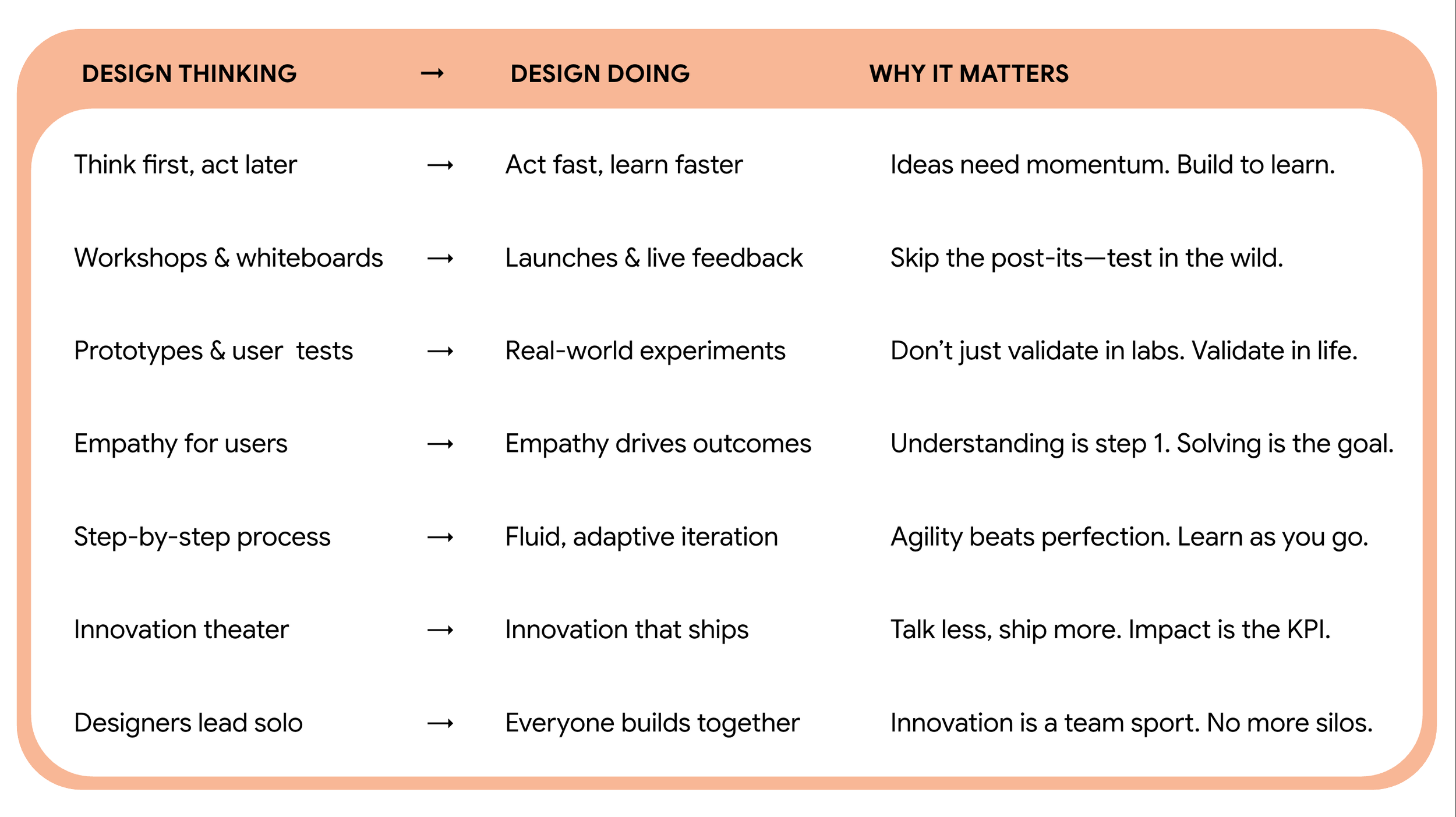Bridging the Gap: The Power of Design Doing
Why Design Thinking Isn’t Enough Anymore
In the ever-evolving landscape of innovation, the transition from ideation to execution is often the most challenging yet crucial phase. This is where my concept of "design doing" comes into play, transforming theoretical frameworks into tangible solutions that make a real-world impact. For me, design doing is more than just a new buzzword; it's a philosophy and #designleadership practice that emphasizes the importance of action and iteration. Unlike design thinking, which traditionally focuses more on generating ideas and conceptualizing solutions, design doing is about rolling up your sleeves and bringing those ideas to life - moving beyond the prototypes and taking an active role in the workshop, where the real impact happens.
My Design Doing Story
As a design leader Walmart E-commerce, I developed a process where my team would create small runs of new products and launch them online as a test. If the products sold well, they would be produced in larger quantities and introduced into Walmart stores. This iterative approach allowed my team to quickly adapt to changing market conditions and consumer preferences, ensuring that the products we developed were always relevant and in demand.
This shift to a 'doing' mindset led to significant impact. Our team effort ended up delivering over a billion dollars in sales through our trend forecasting and product development program. I started by focusing the team on one category of goods, and eventually expanded to 18 categories, including home and bedding, furniture, outdoor furniture, apparel, and electronics. My team developed a wide range of products, from modern baby items to colorful laptops, all designed to meet the needs and desires of Walmart's diverse customer base.
My work at Walmart wasn't just about spotting trends; it was also about making design accessible to everyone. I believed in the mission of Walmart "Save money, live better" and my team worked to create products that were both beautiful and affordable. My team's efforts helped democratize design, bringing high-quality, stylish products to customers who might not have been able to afford them otherwise.
One of the core principles of my design doing mindset is iteration. The first attempt is rarely perfect, and that's okay. The key is to continuously refine and improve, learning from each iteration and making adjustments along the way. This iterative process not only leads to better solutions but also fosters a culture of experimentation and learning.
Collaboration is another cornerstone of design doing. In today's complex and interconnected world, no single individual or team has all the answers. By bringing together cross-functional teams with diverse perspectives and expertise, we can leverage the collective intelligence to create more innovative and effective solutions. This collaborative approach not only enhances the quality of the final product but also ensures that it meets the needs of all stakeholders.
Why Most Ideas Never Get Built
Despite the best intentions, many promising ideas never see the light of day. The barriers to effective Design Doing include:
Lack of Commitment from Leadership: Without executive buy-in, even the most promising ideas can lose momentum. Leaders must champion innovation and allocate resources to bring ideas to life.
Siloed Team Structures: When teams work in isolation, collaboration breaks down, leading to misalignment and inefficiency. Cross-functional teams and integrated workflows are crucial for success.
Resistance to Change: New ideas often challenge existing norms, and resistance from key stakeholders or team members can stall progress. Overcoming this requires early engagement and clear communication about the benefits of change.
Resource Constraints: Many companies struggle with limited funding, staffing, or technology to bring ideas to life. Prioritizing investments and adopting lean methodologies can help overcome these constraints. Hackathons and mini sprints are great practices to consider.
From Design Thinking to Design Doing
To bring ideas to life, we must shift not just our methods — but our mindset. The table below illustrates what it looks like to move from traditional Design Thinking to a more action-oriented philosophy I call Design Doing. It’s a call to trade sticky notes for shipping code, empathy for impact, and planning for progress. Here's how the shift plays out — and why it matters now more than ever.
Design Thinking to Design Doing Mindset Framework by Alice Au Quan
What It Takes to Make Ideas Real
To close the gap between ideation and execution, organizations and individuals must embrace the following strategies:
Prototype Early and Often: The sooner an idea is tested, the faster it can be refined. Rapid iteration reduces the risk of failure and accelerates learning.
Embrace Cross-Functional Collaboration: Bringing together diverse perspectives leads to more holistic and executable solutions.
Secure Leadership Buy-In: Innovation needs champions at the top who are willing to take calculated risks.
Commit to Iteration, Not Perfection: Progress beats perfection. Releasing a minimum viable product (MVP) and refining based on real-world feedback is often more effective than endless internal discussions.
Create a Culture of Execution: Encourage a mindset where taking action is valued just as much as brainstorming ideas.
Nearly a decade has passed since my time at Walmart E-commerce, but the principles of #designdoing remain more relevant than ever, especially in today’s AI-powered world. Back then, we were testing, iterating, and scaling physical products with agility and cross-functional collaboration. Today, those same muscles apply as we prototype AI-powered experiences, train models with real user feedback, and design digital products that adapt in real time. AI can offer speed and scale, but it’s the human practice of doing — of building with purpose, learning in public, and designing with empathy — that ensures we’re creating not just what’s possible, but what’s meaningful. The tools may have changed, but the mindset endures.

